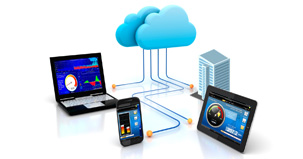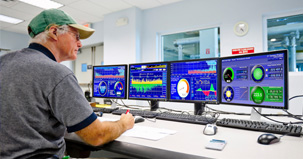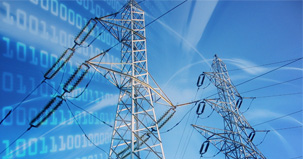- Home
- Smart Data
Smart Data
Actionable intelligence on energy and water use:
- Helps users identify inefficencies, and waste
- Provides real-time feedback on conservation
Right data for the right audience:
- Facility managers identify when and where energy is wasted
- CFO's can track and verify financial savings from initiatives
- Company knows its carbon and water footprint
Related Products
 Information any time, anywhere
Information any time, anywhere - Smart User
Smart User
Smart users leverage real-time data and reduce energy and water use by:
- Continuously identifying opportunities
- Acting on opportunities
- Tracking and verifying savings
- Sustaining savings
Related Products
 Monitor, Manage, Maintain
Monitor, Manage, Maintain - Smart Community
Smart Community
A smart community is one where all stakeholders are engaged in energy and water conservation. A smart community can be achieved by:
- Showing people precisely how much they are using
- Providing real-time feedback on conservation actions
- Effectively communicating efficiency results
Related Products
 Communicate and Conserve
Communicate and Conserve - Smart Grid
Smart Grid
Smart grid, as we define it, is a "green grid", with efficient resource use and the key to a low-carbon future. We help our customers prepare for the smart grid by:
- Engaging users with smart data
- Enabling smart users to increase resource efficiency
- Educating & empowering smart communities
Related Products
 Smart grid and a smarter future
Smart grid and a smarter future - Smart Buildings
Smart Buildings
Smart buildings maximize resource (energy, water, capital) efficiency. These buildings are optimized using energy and water management process with high data visibility which lead to reduced energy and water spending.
- Higher operating income and higher asset values for owners
- Increased productivity for occupants
- Lower carbon footprint for the community
 Resource efficient buildings
Resource efficient buildings
Recent Posts
What is the smart grid?
Most American consumers think of energy use as one-way delivery. Flip a switch and you've got power. Shut it off and it's gone. Until, of course, you need it again. Indeed, the power grid stands at the ready. Or does it?
We get power from the thousands of power plants throughout the United States that generate electricity using wind energy, nuclear energy, coal, hydro, natural gas, and a variety of other resources. While eco-friendly consumers are well aware of the potential that sustainable forms of energy hold, electricity - at least for now - is King. The electricity delivery system in the United States has been in place a long time, and it's getting old. Literally. population growth in some areas has caused the entire transmission system to be over-used and fragile.
At the same time, we have added more electronic devices to our homes and businesses, like computers, high-definition TVs, microwave ovens, wireless telephones, and even electronic controls on refrigerators and dishwashers. These new appliances are more sensitive to variations in electric voltage than old appliances, motors, and incandescent light bulbs.
So, the entire electrical grid is becoming more fragile at the same time the appliances are getting more sensitive to these electrical variations. That's a huge problem.
This problem demands a new approach that significantly increases the efficiency of the entire electrical delivery system. We need a way to not only increase reliability, but also reduce energy in the delivery process, and thereby reduce greenhouse house emissions.
This new approach is known as the Smart Grid.
Smart Grid is a relatively new concept. Perhaps the easiest definition is to compare it to the current electricity grid, which can be considered "dumb." For instance, if power goes out in a neighborhood or building, the local utility often will not be aware of it until a customer calls to inform them.
Think of the Smart Grid as a smarter way to use energy; it's an immediate, two-way communication between utilities and consumers. "Smart" technologies track and advance energy data and implement conservation methods. Additionally, utility companies not only meet the needs of their customers, but offer systems for that usage that can lead to a cleaner, greener planet.
The basic concept of the Smart Grid is to add monitoring, analysis, control, and communication capabilities to the national electrical delivery system; this will maximize the output while reducing the energy consumption. The Smart Grid will allow utilities to move electricity around the system as efficiently as possible. It will also allow businesses to use electricity as economically as possible. Perhaps your tenants want to keep their offices at 70 degrees F in the summer time when prices are low, but may be willing to increase it to 74 degrees F if prices are high.
The Smart Grid builds on many of the technologies already used by electric utilities but adds capabilities that will optimize the operation of the entire electrical grid. Smart Grid is also positioned to take advantage of new technologies, such as various forms of distributed generation, solar energy, smart metering, lighting management systems, and automated distribution, among others.
This modernized electrical delivery system - the Smart Grid - promises to revolutionize the production, delivery and use of electricity worldwide. Enormous investments are underway to move the U.S. toward energy independence and environmentally sustainable economic growth.
But most importantly, it will enable a solid future for our grid - a Smart Grid - and our country's energy economy.
Originally published in greenestatedaily.com



